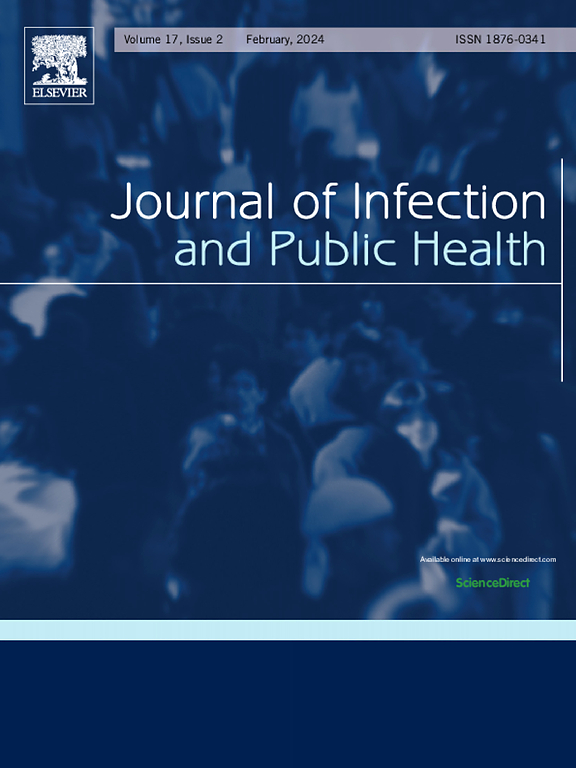Global, regional, and national burden of varicella-zoster infections in adults aged 70 years and older from 1997 to 2021: Findings from the Global Burden of Disease Study
IF 4
3区 医学
Q1 INFECTIOUS DISEASES
引用次数: 0
Abstract
Background
Varicella-zoster virus (VZV) infection gives rise to varicella (chickenpox) and herpes zoster (HZ, shingles). Primary VZV infection results in varicella, while HZ occurs as a consequence of latent VZV reactivation. Older adults are at a significantly elevated risk of HZ because of age-related immune senescence. This study was designed to evaluate the global burden and trends of VZV-related diseases (VHZ: varicella and HZ) among adults aged ≥70 years from 1997 to 2021 and to explore the influencing factors. In this specific age group, VHZ predominantly refers to HZ.
Methods
Data from the Global Burden of Diseases, Injuries, and Risk Factors Study 2021 were employed to estimate the incidence, disability-adjusted life years (DALYs), and rates of VHZ in older adults. Estimated annual percentage changes were utilized to quantify trends, and demographic decomposition analysis was conducted to determine the impacts of population aging, growth, and epidemiological changes.
Results
In 2021, a total of 4,539,519 new VHZ cases were reported globally among older adults, with an incidence rate of 918.2 per 100,000. The global DALYs attributable to VHZ amounted to 113,013, corresponding to a DALY rate of 22.9 per 100,000. From 1997 to 2021, although the incidence rate increased slightly, the DALY rate declined significantly. Population growth was the main driver of the increase in the number of cases, whereas enhanced disease management contributed to the reduction in DALYs.
Conclusions
From 1997 to 2021, the incidence of VHZ in adults aged ≥70 years increased marginally due to population growth, while the disease burden (measured by DALYs) decreased, probably attributed to improved disease management strategies. These trends were particularly evident in regions with a high Socio-Demographic Index (SDI), potentially associated with vaccination efforts, and significant reductions in DALYs were observed in low- and middle-SDI regions, likely owing to advancements in healthcare.
1997年至2021年70岁及以上成年人水痘-带状疱疹感染的全球、区域和国家负担:来自全球疾病负担研究的结果
背景:水痘-带状疱疹病毒(VZV)感染可引起水痘(水痘)和带状疱疹(带状疱疹)。原发VZV感染导致水痘,而HZ是潜伏VZV再激活的结果。由于年龄相关的免疫衰老,老年人患HZ的风险显著升高。本研究旨在评估1997 - 2021年全球年龄≥70岁成人水痘相关疾病(VHZ:水痘和HZ)的负担和趋势,并探讨影响因素。在这个特定的年龄组中,VHZ主要指HZ。方法采用来自2021年全球疾病、损伤和风险因素负担研究的数据来估计老年人VHZ的发病率、残疾调整生命年(DALYs)和发病率。利用估计的年度百分比变化来量化趋势,并进行人口分解分析以确定人口老龄化,增长和流行病学变化的影响。结果2021年,全球老年人中共报告了4539519例VHZ新病例,发病率为918.2 / 10万。全球因VHZ导致的伤残调整年为113,013年,相当于伤残调整年率为每100,000人中22.9人。从1997年到2021年,虽然发病率略有上升,但DALY率明显下降。人口增长是病例数量增加的主要驱动因素,而疾病管理的加强有助于减少伤残调整生命年。从1997年到2021年,年龄≥70岁成人VHZ的发病率由于人口增长而略有增加,而疾病负担(以DALYs衡量)下降,这可能归因于疾病管理策略的改善。这些趋势在社会人口指数(SDI)较高的地区尤其明显,这可能与疫苗接种工作有关,并且在低和中等SDI地区观察到DALYs显著减少,这可能是由于医疗保健的进步。
本文章由计算机程序翻译,如有差异,请以英文原文为准。
求助全文
约1分钟内获得全文
求助全文
来源期刊

Journal of Infection and Public Health
PUBLIC, ENVIRONMENTAL & OCCUPATIONAL HEALTH -INFECTIOUS DISEASES
CiteScore
13.10
自引率
1.50%
发文量
203
审稿时长
96 days
期刊介绍:
The Journal of Infection and Public Health, first official journal of the Saudi Arabian Ministry of National Guard Health Affairs, King Saud Bin Abdulaziz University for Health Sciences and the Saudi Association for Public Health, aims to be the foremost scientific, peer-reviewed journal encompassing infection prevention and control, microbiology, infectious diseases, public health and the application of healthcare epidemiology to the evaluation of health outcomes. The point of view of the journal is that infection and public health are closely intertwined and that advances in one area will have positive consequences on the other.
The journal will be useful to all health professionals who are partners in the management of patients with communicable diseases, keeping them up to date. The journal is proud to have an international and diverse editorial board that will assist and facilitate the publication of articles that reflect a global view on infection control and public health, as well as emphasizing our focus on supporting the needs of public health practitioners.
It is our aim to improve healthcare by reducing risk of infection and related adverse outcomes by critical review, selection, and dissemination of new and relevant information in the field of infection control, public health and infectious diseases in all healthcare settings and the community.
 求助内容:
求助内容: 应助结果提醒方式:
应助结果提醒方式:


